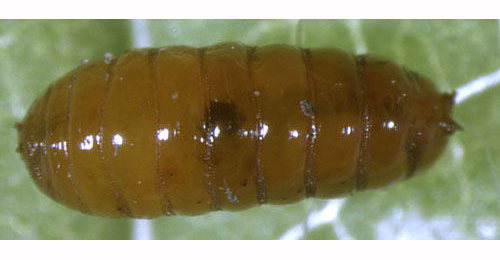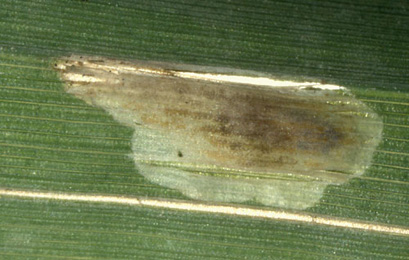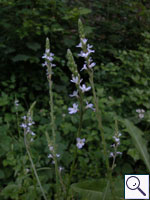|
||||||
|
VERBENA. Vervain. [Verbenaceae] |
|
|
Fourteen species of Verbena are recorded in Britain. Vervain (V. officinalis) is the only native species. Five British miners rae recorded on Verbena. A key to the European miners recorded on Verbena is provided in Bladmineerders van Europa. |
|
Key for the identification of the known mines of British |
1a > Leaf-miner: A distinctive mine primarily above mid-rib, with irregular short lateral offshoots into leaf blade. Pupation external (Spencer, 1972: 51 (fig. 172), 55; Spencer, 1976: 270, 271 (fig. 486)). Branched, whitish, upper-surface corridor; main axis overlying the midrib; side branches overlying the main lateral veins. (In Campanula and Phyteuma the mine is much less branched, sometimes nothing more than a corridor on top of the midrib). Frass in rather long strings. Usually the mines begins as a long and narrow, shallow, tortuous lower-surface corridor that ends upon the midrib but otherwise is not associated with the leaf venation. Often this initial corridor is filled with callus, and then even less conspicuous. Pupation outside the mine. A linear mine on the upper surface, usually following the midrib and showing side branches along the veins. The frass is in strings. |
|
Liriomyza strigata (Meigen, 1830) [Diptera: Agromyzidae]. |
1b > Leaf-miner: A linear-blotch mine, first instar mine is linear, later developing into a conspicuous white blotch. Frass greenish diffused (Spencer, 1972b: 46, 47 (fig. 138); Spencer, 1976: 166). The mine begins with a long, upper-surface, slender corridor. After a moult the larva changes its behaviour, and makes a large, upper-surface primary blotch without apparent feeding lines. Often the blotch overruns more or less the initial corridor. Frass in the corridor liquified to form a wide green band, with a few tiny black granules along the sides. Pupation outside the mine. A narrow gallery leading to a largish blotch on the upper surface. Frass is green and indistinct in the gallery - small grains may be seen at the gallery edge. |
 Amauromyza labiatarum puparium Image: © Willem Ellis (Bladmineerders van Europa) |
|
Amauromyza labiatarum (Hendel, 1920) [Diptera: Agromyzidae]. |
1c > Leaf-miner: In the first instar the larva mines the leaves, forming short, irregular, blotch-like mines, but in later instars it lives externally, feeding in spun leaves and often twisting those of tender shoots. Larval head light-brown or yellowish brown, edged with black postero-laterally, ocellar area blackish; prothoracic plate black edged with whitish anteriorly; abdomen dull dark green; pinacula distinct, black, sometimes brownish but with black bases to setae; anal plate large, black (Bradley et al., 1973). Small, full depth mine without a definite shape; little frass. Some silk is deposited in the mine. The larva soon leaves the mine and continues feeding among spun leaves. |
|
Cnephasia incertana (Treitschke, 1835) [Lepidoptera: Tortricidae]. |
1d > Leaf-miner: Irregular mine, locally shallow, elsewhere much deeper, giving it a mottled appearance. In broadleaved plants the mine often begins as a blotch with stellate extensions, but sometimes as a very fine, shallow corridor. In grasses the mine often begins in the leaf sheath. The frass is very fine-grained, initially scattered, later in aggregates. The egg is deposited on the plant surface, and the empty egg shell remains visible. But the larvae are able to leave their mine and restart elsewhere, thus mines without an egg shell can be found as well. The larva also leaves the mine before pupation. Pupation takes place in a newly made, small, blotch mine without frass; this mine may be made in another plant (species). |
 Mine of Hydrellia griseola on Glyceria fluitans Image: © Willem Ellis (Bladmineerders van Europa) |
|
Hydrellia griseola (Fallén, 1813) [Diptera: Ephydridae]. |
1e > Leaf-miner: A short, irregular, linear upper surface mine on any part of the leaf. Also recorded from young pods (Bland, 1997a). Long corridor mine. As a rule the first part of the mine is lower-surface, the later part upper-surface. Often the loops are so dense that a secondary blotch is the result. Because upper- and lower-surface corridor segments often cross, the mine obtains a strange array of transparant patches. There is no association with the midrib. Frass in strings and thread fragments. Pupation outside the mine; exit slit in upper epidermis. Mine not associated with the veins or midrib of the leaf (It is this character which enables distinction from another Agromyzid pest species - Liriomyza huidobriensis). The larvae may leave one leaf (if not large enough) and enter another leaf, via the petiole). It exits the leaf to pupate through a semi-circular slit in the upper surface of the leaf. |
|
Liriomyza bryoniae (Kaltenbach, 1858) [Diptera: Agromyzidae]. |
| Last updated 13-Feb-2018 Brian Pitkin | ||

